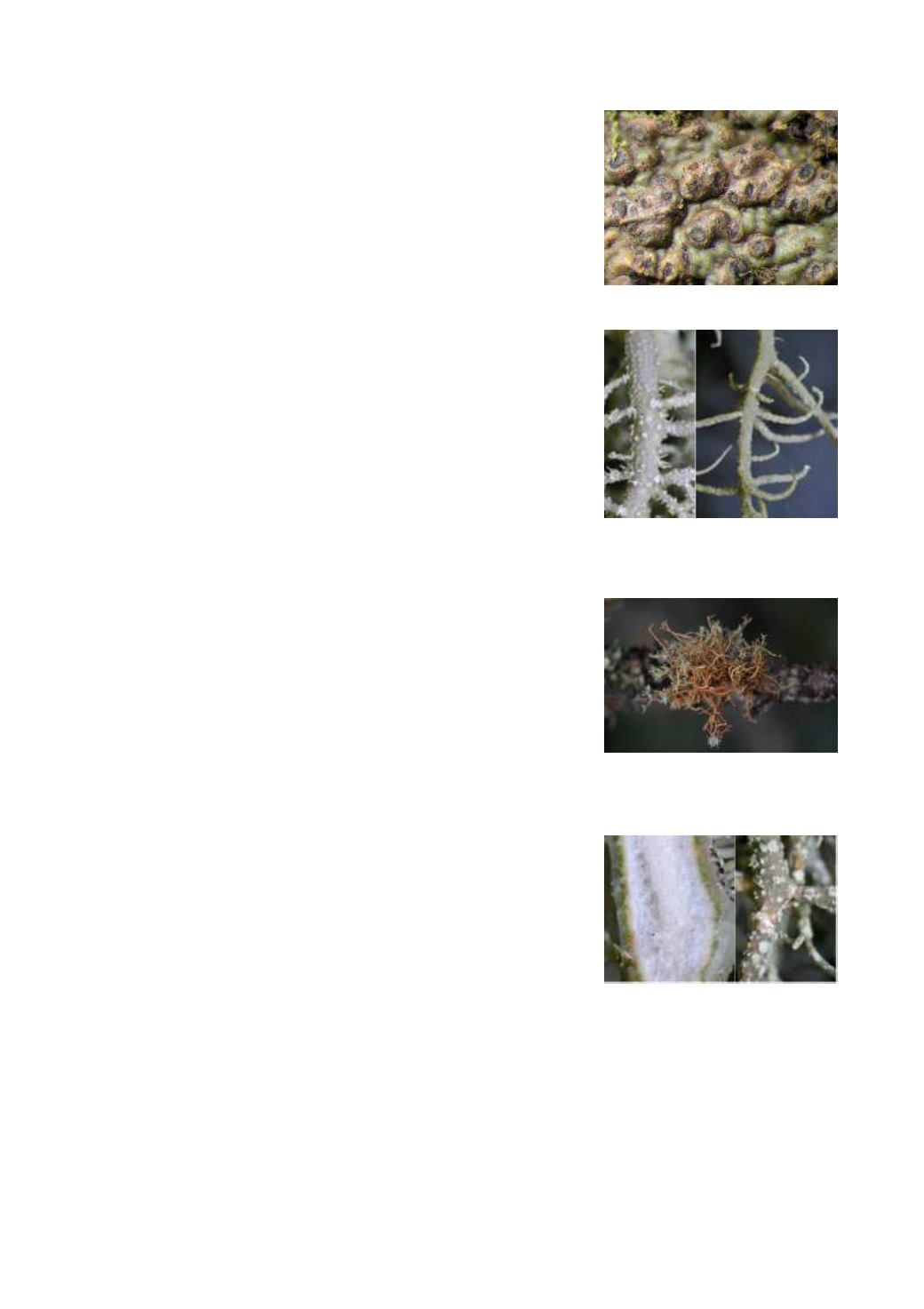
82
ascospores with a gelatinous sheath; lumina diamond-shaped. Photobiont:
Trentepohlia
. - This genus of corticolous lichens is represented by several
species in Sri Lanka, e.g.
T. eluteriae
and
T. epileucodes
.
Usnea cornuta
Körb.
Thallus fruticose, corticolous or saxicolous, filamentous, erect and shrubby,
dichotomously branched, 2–6(–10) cm long, the main branches inflated, the
secondary branches tapering and distinctly constricted at the base, often curved.
The base is the same colour as the branches, or paler. Fibrils present, thick and
short, often numerous on the tips of branches. Papillae few to numerous. Soralia
concentrated at branch tips. Cortex glossy and thin; medulla white, thick,
forming a central chord. Apothecia rare (not seen in Sri Lankan material),
lecanorine. Photobiont: chlorococcoid. Spot-tests: very variable: 1) K+ yellow
turning red, C-, KC-, P + orange yellow, 2) K+ dull yellow turning reddish
orange, C-, KC-, P+ deep yellow, 3) K+ yellow slowly turning orange, C-, KC-,
P+ deep orange, 4) K-, C-, KC-, P+ orange yellow or, 5) K-, C-, KC-, P-. - Rare,
restricted to open humid high elevation forests above 1200 m, on trees, shrubs
and rocks (Horton Plains and Nuwara Eliya District).
Usnea steineri
Zahlbr.
Thallus fruticose, corticolous, filamentous, reddish, erect-shrubby, the main axis
concolorous with the branches, black at the base. The branching is dichotomous,
with tapering to irregular branches. Spinules sparse. numerous. Pseudocyphellae
present on the tubercles. Isidia and soredia absent. Medulla forming a central
chord, with a reddish-orange pigment. Apothecia usually present, lecanorine,
the margin with numerous cilia. Spores colourless, 1-celled. Photobiont:
chlorococcoid. Spot-tests: medulla K+ yellow or yellow to red, P- or P+ orange;
apothecia often KC+ orange. -Rare, restricted to high elevation humid montane
forests above 1400 m, on twigs and small branches in the tree canopy. Also
found in open habitats, forest relics, scrubland, and along roads within
secondary montane cloud forests (Horton Plains and Nuwara Eliya District).
Usnea subcornuta
Stirt.
Thallus fruticose, filamentous, shrubby to subpendent, usually greenish. Lateral
branches slightly constricted at the point of attachment; main branches with
annular cracks. Base pale. Fibrils present, scarce to abundant; papillae absent.
Soralia usually large, with numerous isidia. Cortex glossy; medulla loose in the
outer part, forming a compact central chord, with a subcortical orange pigment.
Apotecia very rare (not seen in Sri Lankan material), lecanorine. Photobiont:
chlorococcoid. Spot tests: medulla K+ yellow to red, P+ orange (stictic and
norstictic acids). - Rare, restricted to humid high elevation forests above 1400
m, on the exposed branches of young trees, on bark or on wood in open places,
in forest relics, in evergreen lower montane forests, and in secondary montane cloud forests (Kalupahana area-
Knuckles mountain region).


